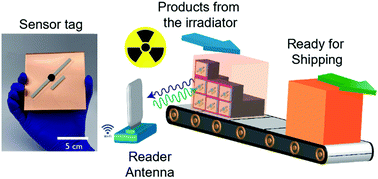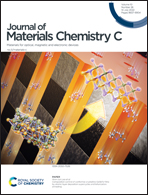A wireless chipless printed sensor tag for real-time radiation sterilization monitoring†
Abstract
Gamma radiation is widely used for the sterilization of many single-use and temperature sensitive medical devices. However, many of such products require an appropriate dose of exposure to achieve proper sterility while having a minimal detrimental effect on the product's function. Therefore, the development of low-cost wireless dosimeters that could be placed in packaged medical products to accurately monitor the level of radiation exposure during the sterilization process is highly desirable. To address this need, here, we have developed an all printed wireless chipless sensor tag technology that allows remote assessment of radiation exposure levels of packaged products through a simple radio frequency (RF) backscattering principle. The sensor tag is composed of a twin printed sensing dipole antenna and reference strip antenna configuration where the sensing antenna is functionalized with an irreversible radiation sensitive conductive polymer blend of poly(3,4-ethylenedioxythiophene):poly(styrene sulfonate) and polyurethane (PEDOT:PSS/PU). The printed reference antenna is unmodified to be insensitive to radiation exposure and provides self-calibration point to each sensor tag. Upon exposure to gamma radiation, the electrical resistance of the PEDOT:PSS/PU polymer blend increases which results in a change in the input impedance and the level of RF power reflected from the sensing antenna. The overall level of radiation exposure of the sensor tag is determined by measuring the differential reflected power from the sensing antenna and reference antenna using a portable RF reader. To identify the optimum radiation sensitive functional material, a systematic sensing study is performed using different ratios of PEDOT:PSS and PU in the radiation exposure range of 0 to 40 kGy. Material characterization results show that the PEDOT:PSS/PU polymer blend at the percolation threshold of 90wt% PU content was capable of providing the highest sensitivity (375% change in impedance after 40 kGy exposure) with excellent stability and repeatability performance. Wireless measurements of the differential reflected power from the sensor tag to the RF reader reveal a high linear sensitivity of 0.1 dB kGy−1 within the working range of 0 to 40 kGy under optimized conditions. The demonstrated platform can provide new opportunities for more cost-effective and non-contact evaluation of radiation sterilization processes in a wide range of food and medical packaging applications.



 Please wait while we load your content...
Please wait while we load your content...